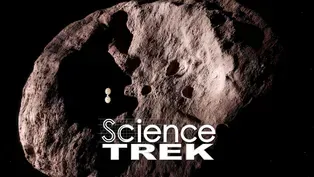
Asteroids and Comets: The Asteroid Belt
Clip: Special | 1m 4sVideo has Closed Captions
What is the biggest asteroid in the Asteroid Belt?
The Asteroid Belt is a part of space between Mars and Jupiter. Find out more about the solar bodies that live in this region of space.
Problems with Closed Captions? Closed Captioning Feedback
Problems with Closed Captions? Closed Captioning Feedback
Science Trek is a local public television program presented by IdahoPTV
Major Funding by the Laura Moore Cunningham Foundation and the Idaho National Laboratory. Additional Funding by the Friends of Idaho Public Television and the Corporation for Public Broadcasting.

Asteroids and Comets: The Asteroid Belt
Clip: Special | 1m 4sVideo has Closed Captions
The Asteroid Belt is a part of space between Mars and Jupiter. Find out more about the solar bodies that live in this region of space.
Problems with Closed Captions? Closed Captioning Feedback
How to Watch Science Trek
Science Trek is available to stream on pbs.org and the free PBS App, available on iPhone, Apple TV, Android TV, Android smartphones, Amazon Fire TV, Amazon Fire Tablet, Roku, Samsung Smart TV, and Vizio.

Science Trek
Science Trek is a place where parents, kids, and educators can watch short, educational videos on a variety of science topics. Every Monday Science Trek releases a new video that introduces children to math, science, technology, engineering, and math (STEM) career potentials in a fun, informative way.(MUSIC) JOAN CARTAN-HANSEN, HOST: Asteroids are among the most ancient objects in the solar system.
A lot are found in the asteroid belt.
This is the area of our solar system just between Mars and Jupiter.
Scientists think there are between one point one and one point nine million asteroids floating around here.
The biggest asteroid in the asteroid belt is Vesta.
It's 329 miles or 530 kilometers in diameter.
Asteroids are divided into three types based on their composition.
M-types asteroids are metallic, made of nickel and iron.
S-type asteroids are made of rocky materials, nickel, and iron.
And C-class asteroids are made of clay and silicate rock.
They're dark in color and are the most common type of asteroid.
Asteroids generally stay within the belt, but occasionally one gets pulled out by Jupiter's gravity.
It can head into the inner solar system, sometimes toward Earth.
NASA has ways to protect the Earth from large asteroids or comet strikes.
But smaller bits of solar body debris hit often.
We see them as shooting stars.
For more information about asteroids and comets, check out the Science Trek website.
You'll find it at ScienceTrek.org
Asteroids and Comets: Lucy and the Trojans
Video has Closed Captions
What are trojans? (And I don’t mean soldiers from Troy) (1m 4s)
Providing Support for PBS.org
Learn Moreabout PBS online sponsorshipSupport for PBS provided by:
Science Trek is a local public television program presented by IdahoPTV
Major Funding by the Laura Moore Cunningham Foundation and the Idaho National Laboratory. Additional Funding by the Friends of Idaho Public Television and the Corporation for Public Broadcasting.












